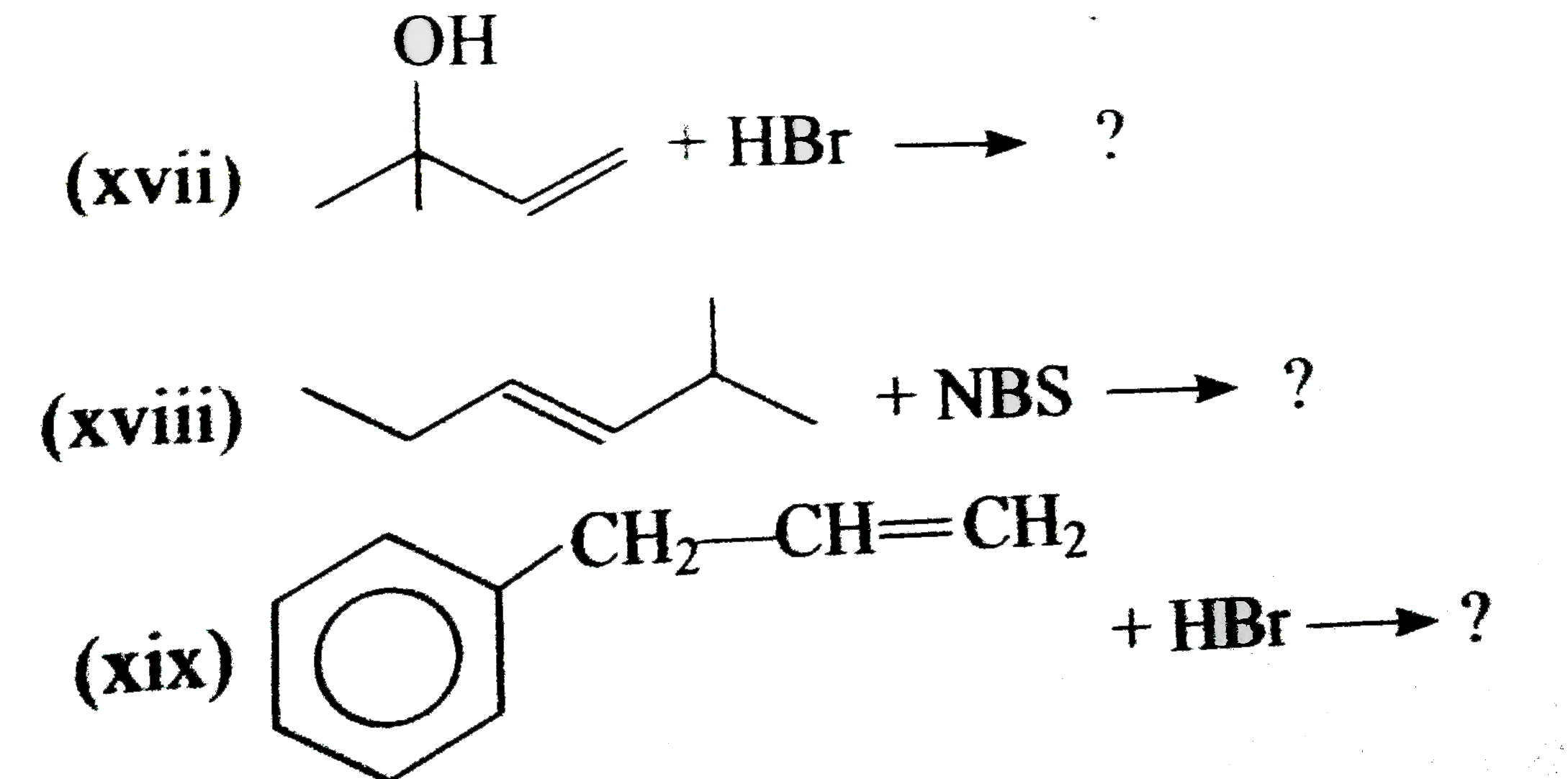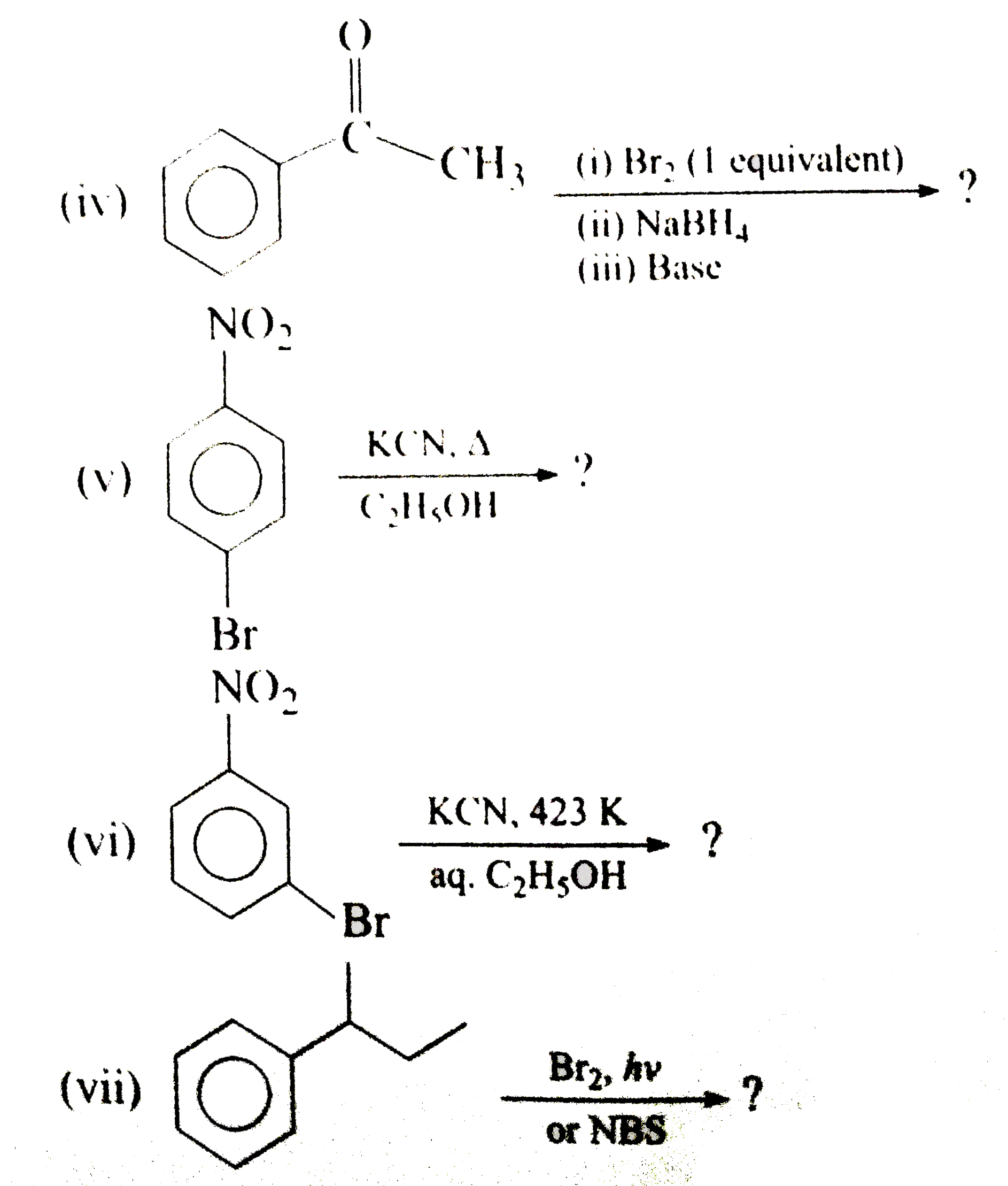H3C−C∣CH3=CH2+HBr→A
A (predominantly) is:
CH3−Br∣C∣CH3−CH2CH3
CH3−C∣BrH−C∣CH3H−CH3
CH3−C∣CH3H−C∣BrH−CH3
CH3−C∣CH3H−CH2−CH2Br
The correct Answer is:A
To solve the problem, we need to analyze the reaction of the given compound with HBr and determine the major product formed. The compound is 2-methylpropene (H3C-CH(CH3)=CH2), and it reacts with HBr.
1. Identify the Reactants:
The reactant is 2-methylpropene (H3C-CH(CH3)=CH2) and it reacts with HBr.
2. Understand the Reaction Mechanism:
HBr dissociates into H⁺ and Br⁻. The H⁺ ion will attack the double bond (C=C) of 2-methylpropene.
3. Formation of Carbocations:
When H⁺ adds to the double bond, two possible carbocations can form:
- Carbocation 1: If H⁺ adds to the terminal carbon (C1), we get a secondary carbocation at C2 (CH3-CH⁺-CH2-CH3).
- Carbocation 2: If H⁺ adds to the middle carbon (C2), we get a more stable tertiary carbocation at C1 (CH3-CH2-CH⁺-CH3).
4. Stability of Carbocations:
The stability of carbocations increases with the number of alkyl groups attached. Tertiary carbocations are more stable than secondary ones.
- Carbocation 1 (secondary) has 1 alkyl group.
- Carbocation 2 (tertiary) has 3 alkyl groups.
5. Select the More Stable Carbocation:
The tertiary carbocation is more stable due to hyperconjugation and inductive effects from the three methyl groups. Therefore, the reaction will proceed through this carbocation.
6. Nucleophilic Attack by Br⁻:
After the formation of the more stable tertiary carbocation, the Br⁻ ion will attack this positively charged carbon, leading to the formation of the product.
7. Final Product:
The major product formed from this reaction is 2-bromo-2-methylpropane (CH3-C(CH3)(Br)-CH3).
Conclusion:
The predominantly formed product A is 2-bromo-2-methylpropane.
The reactant is 2-methylpropene (H3C-CH(CH3)=CH2) and it reacts with HBr.
HBr dissociates into H⁺ and Br⁻. The H⁺ ion will attack the double bond (C=C) of 2-methylpropene.
When H⁺ adds to the double bond, two possible carbocations can form:
- Carbocation 1: If H⁺ adds to the terminal carbon (C1), we get a secondary carbocation at C2 (CH3-CH⁺-CH2-CH3).
- Carbocation 2: If H⁺ adds to the middle carbon (C2), we get a more stable tertiary carbocation at C1 (CH3-CH2-CH⁺-CH3).
The stability of carbocations increases with the number of alkyl groups attached. Tertiary carbocations are more stable than secondary ones.
- Carbocation 1 (secondary) has 1 alkyl group.
- Carbocation 2 (tertiary) has 3 alkyl groups.
The tertiary carbocation is more stable due to hyperconjugation and inductive effects from the three methyl groups. Therefore, the reaction will proceed through this carbocation.
After the formation of the more stable tertiary carbocation, the Br⁻ ion will attack this positively charged carbon, leading to the formation of the product.
The major product formed from this reaction is 2-bromo-2-methylpropane (CH3-C(CH3)(Br)-CH3).
The predominantly formed product A is 2-bromo-2-methylpropane.
Topper's Solved these Questions
- BOOK - MODERN PUBLICATIONCHAPTER - HALOALKANES AND HALOARENESEXERCISE - C. MULTIPLE CHOICE QUESTIONS (with more than one correct answers)10videos
HALOALKANES AND HALOARENES
- BOOK - MODERN PUBLICATIONCHAPTER - HALOALKANES AND HALOARENESEXERCISE - D. MULTIPLE CHOICE QUESTIONS (based on the given passage / comprehension)9videos
HALOALKANES AND HALOARENES
- BOOK - MODERN PUBLICATIONCHAPTER - HALOALKANES AND HALOARENESEXERCISE - A. MULTIPLE CHOICE QUESTIONS (with only one correct answer)35videos
HALOALKANES AND HALOARENES
- BOOK - MODERN PUBLICATIONCHAPTER - EQUILIBRIUMEXERCISE - Unit Practice Test13videos
EQUILIBRIUM
- BOOK - MODERN PUBLICATIONCHAPTER - HYDROCARBONSEXERCISE - UNIT PRACTICE TEST15videos
HYDROCARBONS
Similar Questions
Find the major product
H2C−C∣CH3H−CH=CH2HBr−−→AView Solution(A) What is the final product in each reaction?
(i)C2H5OHI2−−−−−−→NaOH
(ii)CHCI3Ag−−−−−→Heat?
(iii)CHCI3HNO3−−−→?
(iv)CI4Fe/H2O−−−−→?
(v)C6H5NH2CHCI3−−−−−→KOH?
(vi)C4H9BrNaNO2/C2H5OH−−−−−−−−−−→?

(ix)CH3LiCH2=CH2−−−−−−→?
(x)(CH3)3CCI(CH3)2Zn−−−−−−→?
(xi)H2C=CH3∣C−CH2CH3IBr−−→?
(xii)CH3−CH−CH2NBS−−→?
(xiii)CH3−C∣CH3H−CH2CINaI−−−−−−−−−→Acetone,Δ?
(xiv)R3MgX(CH3)2CO/H2O−−−−−−−−−−→?
(xv)CH3−C∣BrH−C∣CH3H−CH3+HBr→?
(xvi)CH3−C∣CH3H−C∣OHH−CH3+HBr→?

(xx)CH3−CH3∣C∣CH3−C∣CIH−CH3+KOH(alc)→?
(xxi)(CH3)3C−CH2Br+KOH(alc)→?
(xxii)CH3−CH3∣C∣CH3−CH2Br+C2H5OHHeat−−→?

(B)(i)C6H5CH2CH3Br2−−−−−→hv?
(ii)C6H5CH2CH3(i)Br2,heat ,light−−−−−−−−−−−−−−→(ii)NaCN,H2O/H?
(iii)CICH2CH2CH2COPhKOH−−−−−−→MeOH?

 View Solution
View Solution
Knowledge Check
- Question 1 - Select One
CH3−C∣CH3H−CH=CH2+HBr→ (product) which is predominate , X is -
ACH3−C∣BrH−C∣CH3H−CH3BCH3−C∣CH3H−C∣BrH−CH3CCH3−C∣CH3H−CH2−CH2BrDCH3−Br∣C∣CH3−CH2CH3 - Question 2 - Select One
H3C−CH∣CH3−CH=CH2+HBr→A.
A is predominantlyACH3−CH∣Br−CH∣CH3−CH3BCH3−CH∣CH3−CH∣Br−CH3CCH3−CH∣CH3−CH2CH2BrDCH3−Br∣C∣CH3−CH2CH3 - Question 3 - Select One
CH3−CH∣CH3−CH=CH2+HBr→'A'
'A' (predominantly) is:ACH3−CH∣Br−C∣CH3H−CH3BCH3−C∣CH3H−C∣BrH−CH3CCH3−CH∣CH3−CH2−CH2BrDCH3−Br∣C∣CH3−CH2CH3
CH3C∣CH3HCH=CH2HBr−−→A
A (predominantly) isView SolutionCH3−C∣CH3H−CH=CH2+HBr→ (product) which is predominate , X is -
View SolutionCH3−C∣CH3=CH2HBr−−−−→PeroxideCH3−CH∣CH3−CH2Br reaction intermediate of this reaction is:
View SolutionThe reaction of HBr with CH3C∣CH3=CH2 in the presence of peroxide will give
View SolutionWhat is the product of the following reaction : CH3−C∣CH3=CH2HBr−−−−→Peroxide
View Solution

